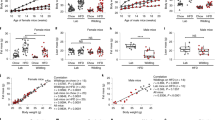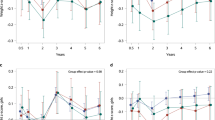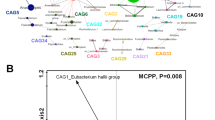Abstract
The intestinal microbiota can influence host metabolism. When given early in life, agents that disrupt microbiota composition, and consequently the metabolic activity of the microbiota, can affect the body mass of the host by either promoting weight gain or stunting growth. These effects are consistent with the role of the microbiota during development. In this Perspective, we posit that microbiota disruptions in early life can have long-lasting effects on body weight in adulthood. Furthermore, we examine the dichotomy between antibiotic-induced repression and promotion of growth and review the experimental and epidemiological evidence that supports these phenotypes. Considering the characteristics of the gut microbiota in early life as a distinct dimension of human growth and development, as well as comprehending the susceptibility of the microbiota to perturbation, will allow for increased understanding of human physiology and could lead to development of interventions to stem current epidemic diseases such as obesity, type 1 diabetes mellitus and type 2 diabetes mellitus.
This is a preview of subscription content, access via your institution
Access options
Subscribe to this journal
Receive 12 print issues and online access
$209.00 per year
only $17.42 per issue
Buy this article
- Purchase on Springer Link
- Instant access to full article PDF
Prices may be subject to local taxes which are calculated during checkout


Similar content being viewed by others
References
Costello, E. K., Stagaman, K., Dethlefsen, L., Bohannan, B. J. M. & Relman, D. A. The application of ecological theory toward an understanding of the human microbiome. Science 336, 1255–1262 (2012).
David, L. A. et al. Diet rapidly and reproducibly alters the human gut microbiome. Nature 505, 559–563 (2014).
Koren, O. et al. Host remodeling of the gut microbiome and metabolic changes during pregnancy. Cell 150, 470–480 (2012).
Zeissig, S. & Blumberg, R. S. Life at the beginning: perturbation of the microbiota by antibiotics in early life and its role in health and disease. Nat. Immunol. 15, 307–310 (2014).
Yatsunenko, T. et al. Human gut microbiome viewed across age and geography. Nature 486, 222–227 (2012).
Martin, R. et al. Early life: gut microbiota and immune development in infancy. Benef. Microbes 1, 367–382 (2010).
Kalliomäki, M., Collado, M. C., Salminen, S. & Isolauri, E. Early differences in fecal microbiota composition in children may predict overweight. Am. J. Clin. Nutr. 87, 534–538 (2008).
Rautava, S., Luoto, R., Salminen, S. & Isolauri, E. Microbial contact during pregnancy, intestinal colonization and human disease. Nat. Rev. Gastroenterol. Hepatol. 9, 565–576 (2012).
Ley, R. E., Lozupone, C. A., Hamady, M., Knight, R. & Gordon, J. I. Worlds within worlds: evolution of the vertebrate gut microbiota. Nat. Rev. Microbiol. 6, 776–788 (2008).
Seekatz, A. M. & Young, V. B. Clostridium difficile and the microbiota. J. Clin. Invest. 124, 1–8 (2014).
Bäckhed, F. et al. The gut microbiota as an environmental factor that regulates fat storage. Proc. Natl Acad. Sci. USA 101, 15718–15723 (2004).
Turnbaugh, P. J. et al. An obesity-associated gut microbiome with increased capacity for energy harvest. Nature 444, 1027–1131 (2006).
Ley, R. E. et al. Obesity alters gut microbial ecology. Proc. Natl Acad. Sci. USA 102, 11070–11075 (2005).
Verani, J. R., McGee, L. & Schrag, S. J. Prevention of perinatal group B streptococcal disease—revised guidelines from CDC, 2010. MMWR Recomm. Rep. 59, 1–32 (2010).
Blaser, M. J. & Falkow, S. What are the consequences of the disappearing human microbiota? Nat. Rev. Microbiol. 7, 887–894 (2009).
Stokholm, J., Sevelsted, A., Bonnelykke, K. & Bisgaard, H. Maternal propensity for infections and risk of childhood asthma: a registry-based cohort study. Lancet Respir. Med. 2, 631–637 (2014).
Broe, A., Pottegård, A., Lamont, R. F., Jørgensen, J. S. & Damkier, P. Increasing use of antibiotics in pregnancy during the period 2000–2010: prevalence, timing, category, and demographics. BJOG 121, 988–996 (2014).
Vidal, A. C. et al. Associations between antibiotic exposure during pregnancy, birth weight and aberrant methylation at imprinted genes among offspring. Int. J. Obes. 37, 907–913 (2013).
Jepsen, P. et al. A population-based study of maternal use of amoxicillin and pregnancy outcome in Denmark. Br. J. Clin. Pharmacol. 55, 216–221 (2003).
Hicks, L. A., Taylor, T. H. & Hunkler, R. J. U.S. outpatient antibiotic prescribing, 2010. N. Engl. J. Med. 368, 1461–1462 (2013).
McCaig, L. F., Besser, R. E. & Hughes, J. M. Trends in antimicrobial prescribing rates for children and adolescents. JAMA 287, 3096–3102 (2002).
Grijalva, C. G., Nuorti, J. & Griffin, M. R. Antibiotic prescription rates for acute respiratory tract infections in US ambulatory settings. JAMA 302, 758–766 (2009).
Ternhag, A. & Hellman, J. More on U.S. outpatient antibiotic prescribing, 2010. N. Engl. J. Med. 369, 1175–1176 (2013).
Hersh, A. L., Jackson, M. A., Hicks, L. A. & American Academy of Pediatrics Committee on Infectious Diseases. Principles of judicious antibiotic prescribing for upper respiratory tract infections in pediatrics. Pediatrics 132, 1146–1154 (2013).
Fridkin, S. et al. Vital signs: improving antibiotic use among hospitalized patients. MMWR. Morb. Mortal. Wkly Rep. 63, 194–200 (2014).
Lee, G. C. et al. Outpatient antibiotic prescribing in the United States: 2000 to 2010. BMC Med. 12, 96 (2014).
Hersh, A. L., Shapiro, D. J., Pavia, A. T. & Shah, S. S. Antibiotic prescribing in ambulatory pediatrics in the United States. Pediatrics 128, 1053–1061 (2011).
Gerber, J. S. et al. Variation in antibiotic prescribing across a pediatric primary care network. J. Pediatric Infect. Dis. Soc. http://dx.doi.org/10.1093/jpids/piu086.
Donoghue, D. J. Antibiotic residues in poultry tissues and eggs: human health concerns? Poult. Sci. 82, 618–621 (2003).
Andersson, D. I. & Hughes, D. Microbiological effects of sublethal levels of antibiotics. Nat. Rev. Microbiol. 12, 465–478 (2014).
Yang, S. & Carlson, K. Evolution of antibiotic occurrence in a river through pristine, urban and agricultural landscapes. Water Res. 37, 4645–4656 (2003).
Buzby, J. C. International trade and food safety: economic theory and case studies. United States Department of Agriculture Economic Research Service, [online] (2003).
[No authors listed] United States National Residue Program for Meat, Poultry, and Egg Products: 2011 Residue Sample Results. [online] (2013).
Marshall, B. M. & Levy, S. B. Food animals and antimicrobials: impacts on human health. Clin. Microbiol. Rev. 24, 718–733 (2011).
Ternak, G. Antibiotics may act as growth/obesity promoters in humans as an inadvertent result of antibiotic pollution? Med. Hypotheses 64, 14–16 (2005).
Riley, L. W., Raphael, E. & Faerstein, E. Obesity in the United States–dysbiosis from exposure to low-dose antibiotics? Front. Public Health 1, 69 (2013).
National Research Council (US) Committee on Drug Use in Food Animals. The use of drugs in food animals: benefits and risks (National Academies Press (US), 1999).
[No authors listed] New animal drugs and new animal drug combination products administered in or on medicated feed or drinking water of food-producing animals: recommendations for drug sponsors for voluntarily aligning product use conditions with GFI #209 [online], (2013).
Nelson, R. FDA action on animal antibiotics could still have loopholes. Lancet Infect. Dis. 14, 376–377 (2014).
Cordle, M. K. USDA regulation of residues in meat and poultry products. J. Anim. Sci. 66, 413–433 (1988).
Done, H. Y. & Halden, R. U. Reconnaissance of 47 antibiotics and associated microbial risks in seafood sold in the United States. J. Hazard. Mater. http://dx.doi.org/10.1016/j.jhazmat.2014.08.075.
Taylor, J. H. & Gordon, W. S. Growth-promoting activity for pigs of inactivated penicillin. Nature 176, 312–313 (1955).
Jukes, T. H. & Williams, W. L. Nutritional effects of antibiotics. Pharmacol. Rev. 5, 381–420 (1953).
Gaskins, H. R., Collier, C. T. & Anderson, D. B. Antibiotics as growth promotants: mode of action. Anim. Biotechnol. 13, 29–42 (2002).
Butaye, P., Devriese, L. & Haesebrouck, F. Antimicrobial growth promoters used in animal feed: effects of less well known antibiotics on gram-positive bacteria. Clin. Microbiol. Rev. 16, 175–188 (2003).
Muir, L. A. Mode of action of exogenous substances on animal growth—an overview. J. Anim. Sci. 61 (Suppl. 2), 154–180 (1985).
Coates, M. E., Fuller, R., Harrison, G. F., Lev, M. & Suffolk, S. F. A comparison of the growth of chicks in the Gustafsson germ-free apparatus and in a conventional environment, with and without dietary supplements of penicillin. Br. J. Nutr. 17, 141–150 (1963).
Ridaura, V. K. et al. Gut microbiota from twins discordant for obesity modulate metabolism in mice. Science 341, 1241214 (2013).
Cho, I. et al. Antibiotics in early life alter the murine colonic microbiome and adiposity. Nature 488, 621–626 (2012).
Cox, L. M. et al. Altering the intestinal microbiota during a critical developmental window has lasting metabolic consequences. Cell 158, 705–721 (2014).
Dubos, R., Schaedler, R. W. & Costello, R. L. The effect of antibacterial drugs on the weight of mice. J. Exp. Med. 117, 245–257 (1963).
Cani, P. D. et al. Changes in gut microbiota control metabolic endotoxemia-induced inflammation in high-fat diet-induced obesity and diabetes in mice. Diabetes 57, 1470–1481 (2008).
Vijay-Kumar, M. et al. Metabolic syndrome and altered gut microbiota in mice lacking Toll-like receptor 5. Science 328, 228–231 (2010).
Henao-Mejia, J. et al. Inflammasome-mediated dysbiosis regulates progression of NAFLD and obesity. Nature 482, 179–185 (2012).
Cox, L. M. & Blaser, M. J. Pathways in microbe-induced obesity. Cell Metab. 17, 883–894 (2013).
Ivanov, I. I. et al. Induction of intestinal Th17 cells by segmented filamentous bacteria. Cell 139, 485–498 (2009).
Jiang, H. Q., Bos, N. A. & Cebra, J. J. Timing, localization, and persistence of colonization by segmented filamentous bacteria in the neonatal mouse gut depend on immune status of mothers and pups. Infect. Immun. 69, 3611–3617 (2001).
Yin, Y. et al. Comparative analysis of the distribution of segmented filamentous bacteria in humans, mice and chickens. ISME J. 7, 615–621 (2012).
Davis, C. P. & Savage, D. C. Effect of penicillin on the succession, attachment, and morphology of segmented, filamentous microbes in the murine small bowel. Infect. Immun. 13, 180–188 (1976).
Hooper, L. V., Littman, D. R. & Macpherson, A. J. Interactions between the microbiota and the immune system. Science 336, 1268–1273 (2012).
Atarashi, K. et al. Induction of colonic regulatory T cells by indigenous Clostridium species. Science 331, 337–341 (2011).
Mazmanian, S. K., Liu, C. H., Tzianabos, A. O. & Kasper, D. L. An immunomodulatory molecule of symbiotic bacteria directs maturation of the host immune system. Cell 122, 107–118 (2005).
Rune, I. et al. Ampicillin-improved glucose tolerance in diet-induced obese C57BL/6N Tac mice is age dependent. J. Diabetes Res. 2013, 1–13 (2013).
Carvalho, B. M. et al. Modulation of gut microbiota by antibiotics improves insulin signalling in high-fat fed mice. Diabetologia 55, 2823–2834 (2012).
Membrez, M. et al. Gut microbiota modulation with norfloxacin and ampicillin enhances glucose tolerance in mice. FASEB J. 22, 2416–2426 (2008).
Murphy, E. F. et al. Divergent metabolic outcomes arising from targeted manipulation of the gut microbiota in diet-induced obesity. Gut 62, 220–226 (2013).
Morel, F. B. et al. Can. Antibiotic treatment in preweaning rats alter body composition in adulthood? Neonatology 103, 182–189 (2013).
Bäckhed, F., Manchester, J. K., Semenkovich, C. F. & Gordon, J. I. Mechanisms underlying the resistance to diet-induced obesity in germ-free mice. Proc. Natl Acad. Sci. USA 104, 979–984 (2007).
Rabot, S. et al. Germ-free C57BL/6J mice are resistant to high-fat-diet-induced insulin resistance and have altered cholesterol metabolism. FASEB J. 24, 4948–4959 (2010).
Fleissner, C. K. et al. Absence of intestinal microbiota does not protect mice from diet-induced obesity. Br. J. Nutr. 104, 919–929 (2010).
Ajslev, T. A., Andersen, C. S., Gamborg, M., Sørensen, T. I. A. & Jess, T. Childhood overweight after establishment of the gut microbiota: the role of delivery mode, pre-pregnancy weight and early administration of antibiotics. Int. J. Obes. 35, 522–529 (2011).
Trasande, L. et al. Infant antibiotic exposures and early-life body mass. Int. J. Obes. 37, 16–23 (2013).
Azad, M. B., Bridgman, S. L., Becker, A. B. & Kozyrskyj, A. L. Infant antibiotic exposure and the development of childhood overweight and central adiposity. Int. J. Obes. 38, 1290–1298 (2014).
Bailey, L. C. et al. Association of antibiotics in infancy with early childhood obesity. JAMA Pediatr. 168, 1063–1069 (2014).
Murphy, R. et al. Antibiotic treatment during infancy and increased body mass index in boys: an international cross-sectional study. Int. J. Obes. 38, 115–119 (2013).
Blustein, J. et al. Association of caesarean delivery with child adiposity from age 6 weeks to 15 years. Int. J. Obes. 37, 900–906 (2013).
Huh, S. Y. et al. Delivery by caesarean section and risk of obesity in preschool age children: a prospective cohort study. Arch. Dis. Child. 97, 610–616 (2012).
Luoto, R., Kalliomäki, M., Laitinen, K. & Isolauri, E. The impact of perinatal probiotic intervention on the development of overweight and obesity: follow-up study from birth to 10 years. Int. J. Obes. 34, 1531–1537 (2010).
Angelakis, E., Merhej, V. & Raoult, D. Related actions of probiotics and antibiotics on gut microbiota and weight modification. Lancet Infect. Dis. 13, 889–899 (2013).
Hill, C. et al. Expert consensus document: The International Scientific Association for Probiotics and Prebiotics consensus statement on the scope and appropriate use of the term probiotic. Nat. Rev. Gastroenterol. Hepatol. 11, 506–514 (2014).
Huovinen, P. Bacteriotherapy: the time has come. BMJ 323, 353–354 (2001).
Dominguez-Bello, M. G., Blaser, M. J., Ley, R. E. & Knight, R. Development of the human gastrointestinal microbiota and insights from high-throughput sequencing. Gastroenterol. 140, 1713–1719 (2011).
Dethlefsen, L., Huse, S., Sogin, M. L. & Relman, D. A. The pervasive effects of an antibiotic on the human gut microbiota, as revealed by deep 16S rRNA sequencing. PLoS Biol. 6, e280 (2008).
Paine, R. T., Tegner, M. J. & Johnson, E. A. Compounded perturbations yield ecological surprises. Ecosystems 1, 535–545 (1998).
Stokholm, J. et al. Antibiotic use during pregnancy alters the commensal vaginal microbiota. Clin. Microbiol. Infect. 20, 629–635 (2014).
Matamoros, S., Gras-Leguen, C., Le Vacon, F., Potel, G. & de La Cochetiere, M. F. Development of intestinal microbiota in infants and its impact on health. Trends Microbiol. 21, 167–173 (2013).
Dominguez-Bello, M. G. et al. Delivery mode shapes the acquisition and structure of the initial microbiota across multiple body habitats in newborns. Proc. Natl Acad. Sci. USA 107, 11971–11975 (2010).
Dubos, R., Schaedler, R. W. & Stephens, M. The effect of antibacterial drugs on the fecal flora of mice. J. Exp. Med. 117, 231–243 (1963).
Jain, N. & Walker, W. A. Diet and host–microbial crosstalk in postnatal intestinal immune homeostasis. Nat. Rev. Gastroenterol. Hepatol. http://dx.doi.org/10.1038/nrgastro.2014.153.
Acknowledgements
This was supported in part by grant T-RO1-DK090989 from the NIH, as well as funding from the Diane Belfer Program in Human Microbial Ecology and the Knapp and Ziff Family foundations.
Author information
Authors and Affiliations
Contributions
L.M.C. and M.J.B. contributed equally to all aspects of the article.
Corresponding author
Ethics declarations
Competing interests
The authors declare no competing financial interests.
Rights and permissions
About this article
Cite this article
Cox, L., Blaser, M. Antibiotics in early life and obesity. Nat Rev Endocrinol 11, 182–190 (2015). https://doi.org/10.1038/nrendo.2014.210
Published:
Issue Date:
DOI: https://doi.org/10.1038/nrendo.2014.210
This article is cited by
-
Gut microbiota in relationship to diabetes mellitus and its late complications with a focus on diabetic foot syndrome: A review
Folia Microbiologica (2024)
-
A microbial causal mediation analytic tool for health disparity and applications in body mass index
Microbiome (2023)
-
Caloric restriction remodels the hepatic chromatin landscape and bile acid metabolism by modulating the gut microbiota
Genome Biology (2023)
-
Antibiotic perturbations to the gut microbiome
Nature Reviews Microbiology (2023)
-
Neonatal prophylactic antibiotics after preterm birth affect plasma proteome and immune development in pigs
Pediatric Research (2023)



